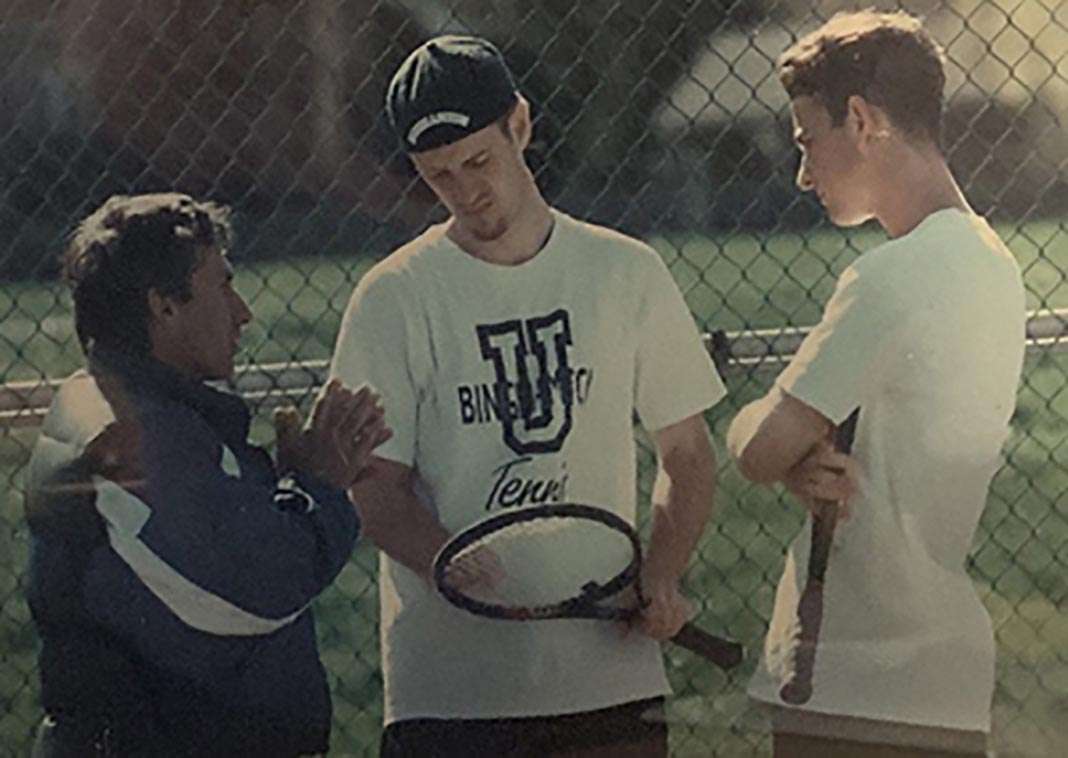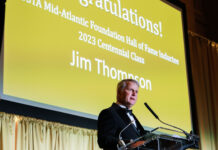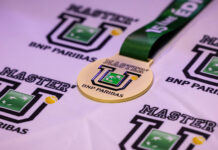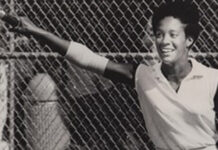By Binghamton Athletics
At his lab at the Winship Cancer Institute of Emory University (Ga.), noted professor and researcher Adam Marcus ’98, PhD, is working vigorously to understand the biology behind cancer – what’s happening at the molecular level – in hopes of someday winning the war against the dreadful disease.
Meanwhile, some 875 miles up the East Coast, David Rosenthal ’97, PhD, is breaking down an enemy of another kind to thousands of college students – Calculus. Rosenthal is a popular, 16-year professor in the Department of Mathematics and Computer Science at St. John’s University.
Some 25 years ago, however, the two broke down opponents together as preeminent tennis players and doubles partners at Binghamton. The names “Marcus and Rosenthal,” dubbed “The Dynamic Duo,” are synonymous with a Binghamton tennis program that forged national success during the mid-1990s.
“Their legacy at Binghamton is better than anything you could ever script,” Hall of Fame coach Michael Starke says. “Adam and Dave embodied the spirit of scholar-athletes and the game of tennis. Fierce competitors with class and impeccable sportsmanship.”
They took different paths to Binghamton but once on campus, Marcus and Rosenthal developed a strong bond as teammates, friends, much to the chagrin of opposing teams.
Rosenthal arrives from Flushing with big serve, heart; Starke lands Marcus one year later
Rosenthal arrived unrecruited in the fall of 1993. He chose Binghamton over a Presidential Scholarship at Albany, citing the school’s academic reputation and tennis strength. He settled into a strong lineup that featured All-American Andrew Magidoff and Rosenthal’s former Townsend Harris High School teammate Ron Sussman. “Rosey” played fourth singles and third doubles for a team that went 13-7 and hit the national rankings at No. 23.
Meanwhile, down in Queens, Marcus was making a name for himself in scholastic tennis. He was ranked No. 9 in the entire East region and Starke was recruiting him with everything he had.
Sophomore Jason Cohen was a teammate of Marcus’ at Cordozo High and told Starke, “Coach get Adam … he will turn your program around.” Starke didn’t have to be told twice.
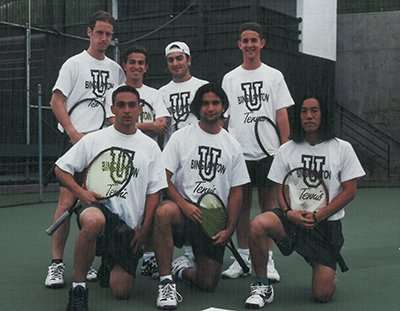
One year later in 1994-95, the team was talented and deep. With new teammates Rosenthal and Marcus in the lineup, BU went 17-4 and earned the program’s first berth to the NCAA Championship (only 12 teams were selected across the country). After winning a match at nationals, Binghamton received a final national team ranking of 10th.
Marcus and Rosenthal were teammates, but it wasn’t the first time they had met. They knew each other from New York City tennis circles and in fact, had trained together on the same court in Bay Terrace, Queens and had squared off a few times in high school.
Marcus wasted no time asserting himself in the college game, quickly snaring the No. 2 singles position, where he posted a team-best 13-2 dual match mark. Marcus then earned a selection (with Magidoff) to the NCAA Singles Championship, winning two matches to reach the round of 16 and become an All-American. He was the ITA East Region Rookie of the Year and only lost seven singles matches all year.
Rosenthal, meanwhile, moved up to No. 4 singles and proceeded to go 21-7.
The doubles pairing of Marcus and Rosenthal debuts in fall 1994
Already boasting a formidable No. 1 doubles tandem of Magidoff and fellow All-American Pavel Shkylar, Starke looked to maximize his lineup with a strong pairing for Rosenthal, whose powerful serve-and-volley game was perfectly suited for doubles. Rosenthal recalls the decision that Starke presented to him.
“Coach knew that finding me a good doubles partner would be key to our team’s success,” he says. “He tried a few combinations that didn’t work out so he finally asked me who I wanted to play with.”
After a talk with his uncle, a tennis aficionado, Rosenthal told his coach he wanted to play with Marcus.

A fall tournament at Middlebury was the scene for the duo’s debut, and Rosenthal, possessing a superb memory, has the detail.
“We had won our first-round match easily and then had to play the No. 1 seeded team from Trenton State in the quarterfinals,” he recounts. “Their best player hit a serve as hard as he could hit it, but Adam belted of one of his patented laser forehand returns that blew by the guy. Adam had no real reaction … he expected to do that every time. But the guy looked at me with this terrified look like, ‘Is he really that good?’ And I looked back at him and nodded, ‘Yup.’ And I remember thinking … ‘Man, this is gonna be fun.’ And of course it was.”
The pairing was a blend of contrasting styles. Starke explains.
“Dave had a strong serve and volley and was great at the net. Adam had a terrific return and his lefty serve wreaked havoc on his opponents, so Dave feasted at the net. They played for each other. They grew and they excelled.”
“Definitely our games just meshed,” Marcus adds. “We worked constantly on our doubles strategy and tried different approaches.”
Pair lifts team to historic eighth place national finish in 1996
The 1995-96 year brought another set of historic milestones for the program. With Marcus entrenched at the top singles spot, Rosenthal wanted to make a statement by being that No. 2 man.
“I always thought that during team introductions when the No. 1 and No. 2 singles players where also the No. 1 doubles team, you knew that those guys were good and that their team was formidable,” he says. “I wanted that for our team, so I knew I had to play No. 2 next to Adam.”
Starke recalls Rosenthal’s improvement.
“Over four years, Rosey evolved into an incredibly focused, confident, clutch player.”
With Marcus and Rosenthal occupying the top two singles spots and forming the No. 1 doubles team, Binghamton rolled through its regional opponents and hosted the inaugural NCAA East Regional as the No. 4 seed. In the semifinals, moved indoors to Cornell’s Reis Tennis Center, BU faced the nation’s fifth-ranked team in undefeated and top-seeded Williams. Marcus and Rosenthal opened with a win over the region’s No. 2 ranked pair and Marcus then posted a win at No. 1 singles, helping BU maintain a narrow edge. After several hours, all eyes were on the No. 2 singles court, where Rosenthal was engaged in a duel with the No. 3 player in the region. He fended off a 6-5 deficit in the third set, forced a tiebreaker and clinched the team’s stunning 4-2 upset with a 7-5 tiebreak triumph.
The win sent the Colonials down to Emory for the NCAA quarterfinals and a program-best final ranking of 8th in the nation. Little did Marcus know that he was playing on the highest national stage at an Emory University tennis complex that would later be a stone’s throw away from his current laboratory at Winship Cancer Institute.
The year concluded with All-America doubles honors for the pair, who were seeded No. 2 in the national doubles draw and went 18-4 on the season. Marcus also reached the NCAA singles round of 16 and earned All-America honors with a 20-6 campaign. Rosenthal, meanwhile, lost just five singles matches all year – the fewest of any Colonial.
Final season together in 1997
The 1996-97 campaign was Rosenthal’s senior season and final go-around as a collegiate athlete. He and Marcus were co-captains and anchors at the top of the singles and doubles lineup. While the team fell short of a third straight NCAA Finals berth, they earned a No. 11 national ranking, thanks to the heavy lifting of Marcus and Rosenthal. They defended their doubles title at the prestigious Rolex Northeast Regionals and met as foes for the singles crown, making a strong case as the top two players in the entire region.
Rosenthal capped his career with yet another Academic All-America honor and he and Marcus earned their second-straight doubles All-America honors and finished their run together with a career 48-15 doubles record. At the year-end Awards Banquet, Rosenthal was presented with the Foundation Award, given to the one student-athlete who best exemplifies leadership and achievement. He also was selected to speak at the banquet, sharing his collegiate experience with the 400+ student-athletes across all 21 sports.
Rosenthal also had impeccably juggled graduate courses during his final year, having already earned his undergraduate degree in three years.
Marcus concludes his illustrious career one year later
Marcus finished his career one year later, guiding the 1997-98 team to a final ranking of 18th and earning his fifth All-America honor. His numerous accolades included winning another ITA regional doubles crown, reaching the NCAA singles round of 16, receiving the ITA East Region Arthur Ashe Collegiate Award for outstanding leadership and sportsmanship and then earning the department’s prestigious John Bilos Award for career achievement. He graduated with the most singles wins in program history (74) and his combined singles and doubles win percentage (70%) ranks among the highest in the sport’s long history. He was inducted into BU’s Athletics Hall of Fame in 2009.
Rosenthal continues down path toward teaching mathematics
While Marcus was concluding his collegiate playing career, Rosenthal remained on campus working toward his master’s degree (1998) and PhD (2002) in mathematics. Having two uncles who were professors, he was locked into that career path early.
“I knew early on that I wanted to be a math professor,” he says. “It’s a wonderful job. You get to study what you like and find interesting, you’re constantly learning from your research, you have the opportunity to make connections with colleagues from around the world and also working with and mentoring students is very energizing and rewarding.”


